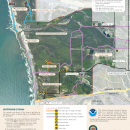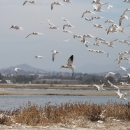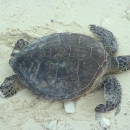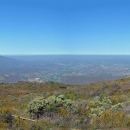Visit Us
Although not required, binoculars are a great way to closely see some of the 370 bird species that have been seen on the refuge.
Summer months can be very hot especially during the middle of the day. It is highly recommended that visitors wear sun protection, a wide brim hat, and carry water.
Tijuana Slough National Wildlife Refuge is adjacent to a U.S. Navy Landing Field and it is not unusual to see and hear helicopters flying throughout the week besides Sunday’s or early mornings.
Activities
At the visitor center, you may pick up trail maps, wildlife information, or ask the front desk staff any questions you may have, between the hours of 10:00 am and 5:00 pm, Wednesday through Sunday. You may also purchase books or shirts at the gift shop, which benefits the Friends of San Diego Wildlife Refuges. Restrooms can be found adjacent to the Tijuana Estuary Visitor Center and are open daily from 9:00 a.m. to 5:00 p.m.
Most of the trails are dog-friendly, however they must be leashed at all times on a 6-foot or shorter leash, and you must pick up after your pet.
Wildlife Viewing - If you enjoy getting outdoors and looking for wildlife, consider a visit to your nearest national wildlife refuge national wildlife refuge
A national wildlife refuge is typically a contiguous area of land and water managed by the U.S. Fish and Wildlife Service for the conservation and, where appropriate, restoration of fish, wildlife and plant resources and their habitats for the benefit of present and future generations of Americans.
Learn more about national wildlife refuge ! From birding on the trails to whale watching from the beach, from viewing hunting hawks or secretive Light-footed Ridgway’s rails, wildlife observation is the most popular activity for refuge visitors. Tijuana Slough NWR has an extensive trail system that connects to other trails within the Reserve and has several boardwalks or observation decks to stop and discover the unique flora and fauna right in the midst of a highly urbanized environment.
Interpretation - Tijuana Slough NWR interpretation programs provide opportunities for visitors to make their own connections to the natural world. From docent-led walks to guest speaker talks, our informal education programs help visitors learn more about wildlife, habitat restoration, ecology and climate change climate change
Climate change includes both global warming driven by human-induced emissions of greenhouse gases and the resulting large-scale shifts in weather patterns. Though there have been previous periods of climatic change, since the mid-20th century humans have had an unprecedented impact on Earth's climate system and caused change on a global scale.
Learn more about climate change by listening to experts in the field.
Environmental Education - National Wildlife Refuges serve many purposes, and one of our most important roles is as outdoor classrooms to teach about wildlife and natural resources, with hands-on learning activities. Thousands of youth and adult groups visit every year to learn about topics on wetland plants, birds, plankton, and their habitats. If you are an educator, take a look at these resources related to this refuge.
Photography - Perhaps the fastest growing activity on national wildlife refuges in the past ten years has been wildlife photography.
Nearly 12 million people visit outdoor areas each year to photograph wildlife, and national wildlife refuges naturally are at the top of the list. Refuges provide enhanced opportunities to photograph wildlife in natural habitats by providing platforms, brochures, interpreters, viewing areas, and tour routes. We welcome beginning and expert photographers alike to record their outdoor adventures on film, memory card or internal hard drive!
Related Documents
The Visitor Center is located at 301 Caspian Way, Imperial Beach, CA 91932.
There is no charge to visit.
Directions from the north:
Take Interstate 5 south to the Coronado Avenue exit in Imperial. Turn right onto Coronado Ave. for about three miles (it becomes Imperial Beach Blvd.). Turn left onto Third Ave. and at the four-way stop (you'll see the Reserve's concrete sign). Follow the road around the corner and the Visitor Center will be on the right.
Directions from the south:
Take Interstate 5 north and turn left on Coronado Ave., then follow the directions above.
Other Facilities in the Complex
Tijuana Slough National Wildlife Refuge is managed as part of the San Diego National Wildlife Refuge Complex. The Refuge complex is comprised of Seal Beach NWR, San Diego Bay NWR, San Diego NWR, and Tijuana Slough NWR.
Tijuana Slough National Wildlife Refuge is also a part of the 2,800-acre Tijuana River National Estuarine Research Reserve, one of only 28 such reserves in the United States.
Rules and Policies
- Dogs must be leashed at all times on a 6-foot or shorter leash, and you must pick up after your pet.
- Hunting is not allowed
- Launching, landing or disturbing of wildlife by aircraft (drones) is prohibited as stated in 50 CFR 27.34/27.51
- Disturbing or collecting any plant, animal, or physical features (shells, rocks, etc.) is prohibited.
- Alcohol and drugs are not allowed.
- Camping, open fires, and fireworks are prohibited.
- Tijuana Slough National Wildlife Refuge should be a quiet place to enjoy nature. Leave fireworks, loud radios, and other sound equipment at home.
- Fishing, clamming, and shrimping are permitted from the beach area only.









